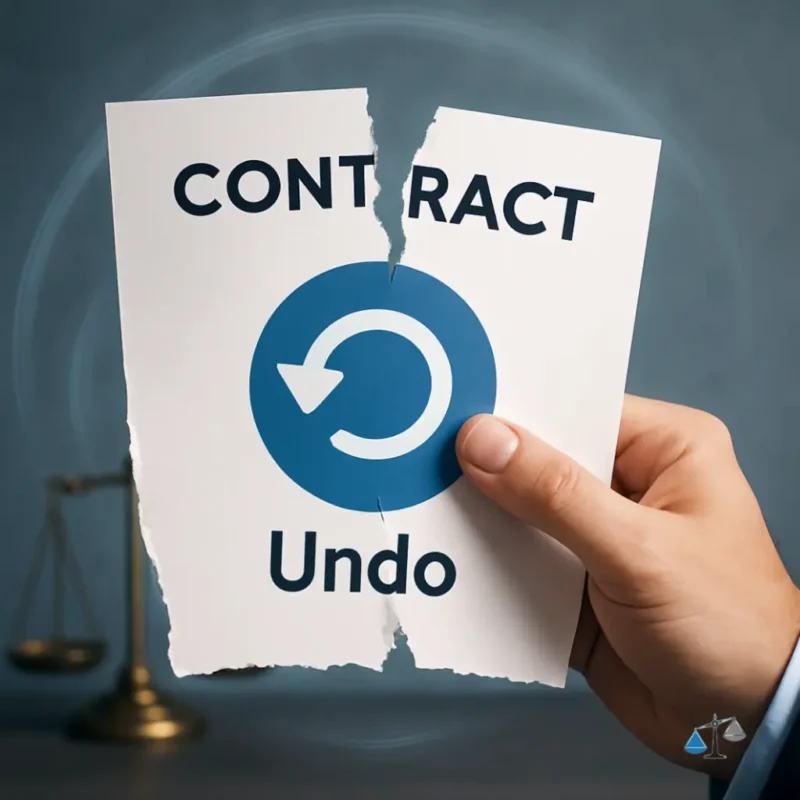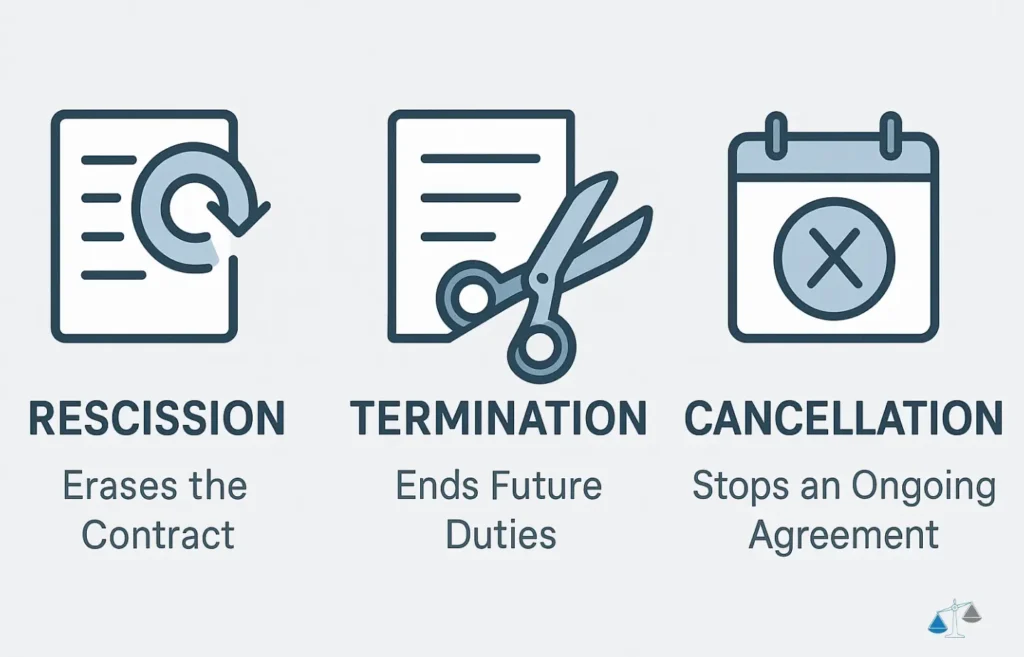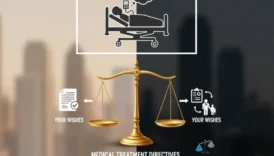What Is Legal Rescission?

- What Is Legal Rescission?
- The Definition of Rescission: A Full Explanation of its Meaning
- What Does it Mean to "Rescind" a Contract?
- The Main Goal: Returning to the Status Quo Ante
- The Two Types of Rescission Explained
- Rescission vs. Termination vs. Cancellation: Understanding the Key Differences
- What Are the Reasons for Rescission? (Common Grounds)
- Mutual Consent: When Both Parties Agree to Walk Away
- Problems with the Contract's Formation
- Statutory Rights: The Consumer "Cooling-Off" Rule
- The Process of Rescission: A Step-by-Step Overview
- Step 1: Providing a Notice of Rescission
- Step 2: Tender or Restoration
- Step 3: Taking Legal Action (If Necessary)
- What Are the Consequences of Rescission?
- Frequently Asked Questions (FAQ)
- Conclusion: The Power of the "Undo Button"
Have you ever signed a contract and felt an immediate wave of regret? That feeling of “signer’s remorse” is a common one, whether it’s for a car, a new service, or a business deal that seemed perfect at the moment. In the world of law, there’s a powerful concept designed for these exact situations: legal rescission.
Think of rescission as the ultimate “undo button” for a contract. It’s not just about canceling future obligations; it’s a legal process that voids the agreement entirely, treating it as though it never existed in the first place. It aims to turn back the clock and put both parties back in the financial position they were in before the contract was ever signed.
But how does it work? When can you actually use this legal “Ctrl+Z”?
This article will provide a complete explanation of legal rescission. We’ll cover its official definition, its true meaning in the eyes of the law, clear examples, and the specific reasons that allow you to rescind a contract.
The Definition of Rescission: A Full Explanation of its Meaning
While many people use “rescind” and “cancel” interchangeably in everyday conversation, in the legal world, rescission has a very specific and powerful meaning. Understanding this definition is the key to grasping its impact.
What Does it Mean to “Rescind” a Contract?
To rescind a contract is to extinguish it, void it, and render it null, effective from the very beginning. The legal system essentially treats the contract as if it were never created.
This isn’t simply about stopping future payments or ending a service. A cancellation might stop future obligations, but it acknowledges the contract was valid up to that point. A rescission, on the other hand, goes back in time to erase the contract’s existence entirely. It is a complete unwinding of the agreement.
The Main Goal: Returning to the Status Quo Ante
The ultimate objective of rescission is to restore all parties to their original positions—the state they were in before the contract was signed. The legal term for this is “status quo ante,” a Latin phrase that literally means “the state in which before.”
This requires each party to return any money, property, or benefit they received from the other party under the contract.
Example in Plain English: Imagine you buy a vintage guitar for $1,000. You later discover the seller lied about its authenticity (a reason for rescission). If the contract is rescinded:
- You must return the guitar to the seller.
- The seller must return your $1,000. The goal is to make it so the transaction, in the eyes of the law, never happened.
The Two Types of Rescission Explained
This legal “undo” can happen in two primary ways, directly answering the common question, “What are the two types of rescission?”
- Rescission by Mutual Agreement: This is the most straightforward type. Both parties acknowledge that the contract is not working out or was based on a misunderstanding. They mutually agree to rescind it, voluntarily returning any goods or payments, and walk away. No court is needed.
- Unilateral Rescission (or Rescission for Cause): This is when only one party has the legal right to rescind the contract due to a significant issue with the agreement itself (like being a victim of fraud, duress, or a material mistake). This party informs the other that they are rescinding the contract. If the other party disagrees and refuses to return the money or property, the matter may have to be settled in court.
Rescission vs. Termination vs. Cancellation: Understanding the Key Differences

In the world of contracts, words matter—a lot. While “rescission,” “termination,” and “cancellation” might sound like synonyms for ending an agreement, they have vastly different legal meanings and consequences. Mistaking one for another can lead to significant confusion.
The table below breaks down the core differences in a clear, side-by-side comparison.
| Feature | Rescission | Termination | Cancellation |
| Effect on Contract | Voids the contract as if it never existed. | Ends a valid contract from this point forward. | Ends a valid contract from this point forward. |
| Timeline | Retroactive (Geriye dönük). The clock is turned back. | Prospective (İleriye dönük). The past is acknowledged as valid. | Prospective (İleriye dönük). Past performance is usually valid. |
| Main Goal | To return both parties to their pre-contract state (status quo ante). | To end the parties’ obligations according to the terms of the contract itself. | To stop future performance, often for a recurring service or statutory right. |
| When It’s Used | When there’s a fundamental flaw in the contract’s formation (fraud, mistake, duress, etc.). | When a specific clause is met (e.g., breach of contract, end of a fixed term, mutual agreement to end). | When a party exercises a right to cancel (e.g., a gym membership, a subscription, a consumer “cooling-off” period). |
In short, the easiest way to remember the difference is to think about the contract’s history. Rescission erases that history. Termination and cancellation respect that history but end the story from the current chapter onward.
What Are the Reasons for Rescission? (Common Grounds)
You can’t rescind a contract simply because you changed your mind or found a better deal later (this is what’s known as “buyer’s remorse”). There must be a legally recognized reason—or “grounds”—that justifies voiding the entire agreement. These reasons typically relate to a fundamental problem with how the contract was formed.
Mutual Consent: When Both Parties Agree to Walk Away
This is the simplest and cleanest path to rescission. If both parties agree that the contract was a mistake or is no longer desirable, they can voluntarily agree to rescind it. They create a new agreement (often called a rescission agreement) to unwind the original contract, return any goods or money, and release each other from all obligations.
Problems with the Contract’s Formation
Most contested rescissions happen because one party claims there was a serious flaw when the contract was made. This means the agreement wasn’t based on a true and fair “meeting of the minds.” Common grounds include:
- Material Misrepresentation and Fraud: This occurs when one party makes a false statement about a crucial fact to induce the other party to sign. It can be an outright lie (fraud) or an unintentional but significant falsehood (misrepresentation).
- Example: A seller tells you a car has never been in an accident. You buy it, then discover it has a history of major collision damage. You were misled about a material fact.
- Lack of Legal Capacity: A contract is only valid if both parties have the legal ability, or “capacity,” to make one. If a party lacks capacity, the contract is often voidable.
- Example: A 16-year-old signs a contract for a long-term mobile phone plan. Since they are a minor, they generally lack the legal capacity to be bound by that contract and can choose to rescind it.
- Duress or Undue Influence: This means a party was forced or improperly pressured into signing the contract against their will.
- Duress: “Sign this contract, or else…” This involves a threat of harm.
- Undue Influence: This is more subtle. It often involves a person in a position of trust (like a caregiver or family advisor) taking advantage of someone’s weakness or dependence to get them to sign an unfair contract.
- Mistake: If both parties made a significant mistake about a fundamental assumption of the contract (a “mutual mistake”), it may be grounds for rescission.
- Example: You agree to buy a painting from a gallery, and both you and the seller believe it’s an original masterpiece. Later, it’s discovered to be a very good fake. Since the contract was based on a mutual mistake about the painting’s authenticity, it could be rescinded.
Statutory Rights: The Consumer “Cooling-Off” Rule
In some specific situations, federal and state laws give consumers an automatic right to rescind a contract within a certain period, even without any flaw in the contract itself. This is often called a “cooling-off” period.
The most well-known example is the Federal Trade Commission’s (FTC) “Cooling-Off Rule,” which gives you three days to cancel certain sales made at your home or a location that is not the seller’s permanent place of business. Many states have similar laws for things like home equity loans (mortgage refinancing), timeshare purchases, and health club memberships.
The Process of Rescission: A Step-by-Step Overview
Successfully rescinding a contract involves more than just declaring your intent. To ensure the process is legally sound, there are formal steps that must be followed. While the specifics can vary by state and situation, the general process typically involves the following.
Step 1: Providing a Notice of Rescission
The first formal step is to provide a clear and unequivocal Notice of Rescission to the other party. This is a written document that officially communicates your intent to void the contract.
Your notice should clearly:
- State that you are rescinding the agreement.
- Identify the contract, including its date and subject matter.
- Explain the legal grounds (the reasons) for the rescission (e.g., “due to a material misrepresentation of the property’s condition”).
This notice creates a crucial paper trail and formally puts the other party on alert.
Step 2: Tender or Restoration
At the same time you provide notice, you must also offer to return any benefit you have received from the contract. This is known legally as “tender” or an “offer of restoration.” This step demonstrates your commitment to returning both parties to the status quo ante.
For instance, if you are rescinding a contract for a used car, your notice should state that you are prepared to return the car in exchange for a full refund of the purchase price. You must be ready and able to give back what you got.
Step 3: Taking Legal Action (If Necessary)
In an ideal world, the other party will accept your notice of rescission, and you will both proceed with the restoration. However, if the other party disputes your right to rescind and refuses to cooperate, your final step may be to file a lawsuit.
In this case, you would ask a court to formally recognize the validity of your rescission. A judge would review the evidence, determine if your grounds are legally sufficient, and if so, issue a court order that enforces the rescission and compels the return of any property or funds.
What Are the Consequences of Rescission?
When a contract is successfully rescinded, the outcome is straightforward but profound. The legal consequences are designed to fully unwind the transaction and effectively erase it from legal existence. Here are the primary results:
- The Contract Becomes Void: The most significant consequence is that the contract is rendered null and void. It becomes legally unenforceable, meaning neither party can go to court to compel the other to perform any of the contract’s terms. For all legal purposes, the agreement no longer exists.
- Future Obligations Are Extinguished: Because the contract is considered to have never existed, all duties and obligations under it are completely wiped away. Any future payments, services, or other actions that would have been required are no longer necessary.
- Restitution Is Required: This is the practical part of making things right. Both parties are legally required to return whatever they received from the other under the contract. This process is called restitution. The goal is to restore each party to their original financial position (status quo ante).
- If you paid money, it must be refunded to you.
- If you received goods or property, you must return them.
- If a service was performed, a court might require a reasonable payment for the value of that service to prevent unjust enrichment.
- Damages Are Generally Not Awarded: Unlike a breach of contract lawsuit where the goal is often to recover monetary damages for lost profits or other harms, the primary remedy in rescission is restitution. The goal isn’t to punish the other party but to undo the deal. The main exception is in cases involving fraud, where a court may sometimes award additional damages to compensate the victim for any harm suffered.
In essence, the ultimate consequence of rescission is a complete and total reset. It’s a legal remedy that aims to make it as though the contract never happened at all.
Harika, makalemizi en sık sorulan sorulara vereceğimiz net yanıtlar ve genel bir sonuç bölümüyle tamamlıyoruz.
Frequently Asked Questions (FAQ)
1. How long do I have to rescind a contract? The time limit, known as the “statute of limitations,” varies significantly depending on the reason for the rescission and state law. For issues like fraud, it could be a few years from the date the fraud was discovered. For specific consumer contracts under the “Cooling-Off Rule,” you may only have three days. The most important rule is to act promptly as soon as you discover the grounds for rescission.
2. Is “buyer’s remorse” a valid reason for rescission? No. Simply changing your mind or finding a better deal after signing a contract is not a legally valid reason to rescind it. Rescission requires a fundamental flaw in the way the contract was formed, such as misrepresentation, mistake, or duress.
3. What is the difference between a void and a voidable contract? A void contract is illegal from the moment it’s created and is unenforceable by anyone (e.g., a contract to commit a crime). A voidable contract is a valid contract that one party has the legal right to either enforce or rescind due to a flaw. Most contracts subject to rescission (like those signed by a minor or based on fraud) are considered voidable.
4. Can I rescind a contract for a car after I drive it off the lot? This is very difficult. Driving the car off the lot generally signifies your acceptance of the contract. To rescind it, you would need to prove one of the specific legal grounds, such as the dealer committing fraud by intentionally misrepresenting the car’s history (e.g., hiding a salvage title or lying about the mileage).
5. Do I always need a lawyer to rescind a contract? Not always. If both parties mutually agree to rescind, you can often do it with a simple written rescission agreement. However, if you are attempting a unilateral rescission because you believe you have legal grounds and you expect the other party to dispute it, consulting with a lawyer is highly recommended to protect your rights and ensure you follow the correct legal procedures.
6. What happens if I can’t return the property in its original condition? The goal of rescission is fairness. If you’ve used a service or a product and it cannot be returned in its exact original state, a court may require you to pay a reasonable amount for the benefit you received (this is known as “quantum meruit”). The aim is to prevent one party from being unjustly enriched while still unwinding the core of the contract.
Conclusion: The Power of the “Undo Button”
Legal rescission is one of the most powerful remedies in contract law, but it is also one of the most specific. It’s far more than a simple cancellation; it is a complete reset, designed to take the parties back in time as if their agreement never happened. While it provides a crucial escape hatch from contracts formed under flawed circumstances—like fraud, misrepresentation, or duress—it is not a cure for simple regret. The key takeaway is to enter into contracts with care and awareness, but to also understand that the law provides a path to recourse when an agreement is fundamentally unfair from its inception.






